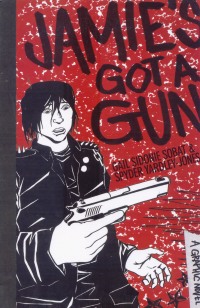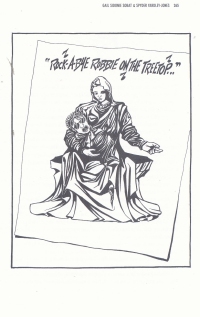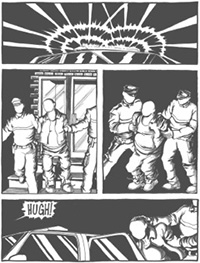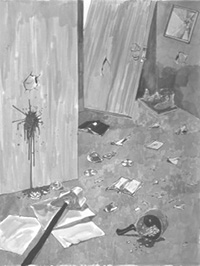| ________________
CM . . . . Volume XXI Number 3 . . . . September 19, 2014
excerpt:
The novel is told in alternating full-text pages and graphic novel style sequences, giving the novel some helpful complexity to keep readers engaged. The graphic novel elements help to complement certain aspects of the narrative style and also help to illustrate-literally-Jamie's artistic personality. Since the novel is written as a journal, the images help to convey that particular aspect of Jamie's character. One particularly intriguing aspect of the illustration is that the only individual who is drawn without a face is Hugh; this facelessness serves to emphasize Jamie's lack of emotional attachment where Hugh is concerned. The graphic novel sections also serve another purpose, allowing Jamie to illustrate and construct alternative timelines and imagine moments that are not real.
Some of the dialogue between teen characters-particularly Jamie and Tatiana-is a bit on-the-nose and causes the narrative to feel like an adult author trying to sound like a teenager. These moments drew me out of the story, causing me to question whether or not teen readers will see Jamie as authentic. The narrative voice becomes more stable in the second half of the novel, though, and I was able to become more engrossed in the plot and character development.
There is also one particular factual error in which Jamie mentions taking his sister to see a movie-The Graveyard Book-when in actual fact, the surrounding evidence causes me to believe the book is actually referring to Coraline. I was also hoping for a bit more development with the secondary plot about Tina's disappearance, and Jamie's run-in with her pimp; that part of the plot never quite felt finished. Quibbles aside, though, Jamie's Got a Gun is intriguing and effective in its use of text and illustration and will appeal to teen readers who are looking for gritty and uncompromising fiction. Recommended. Rob Bittner recently graduated from the MA in Children's Literature program at The University of British Columbia and is now a PhD student in Gender, Sexuality, and Women's Studies at Simon Fraser University in Burnaby, BC. Copyright © the Manitoba Library Association. Reproduction for personal use is permitted only if this copyright notice is maintained. Any other reproduction is prohibited without permission.
Next Review |
Table of Contents for This Issue
- September 19, 2014. |

 Sobat and Yardley-Jones' graphic novel-perhaps closer to an illustrated novel-is a gritty narrative told from the perspective 17-year-old Jamie Kidding, a budding artist, who just recently found a handgun. Jamie lives with his sister, Candy, his mother, and his mother's abusive boyfriend, Hugh. When Hugh comes home one night and puts Jamie's mother in the hospital, Jamie starts to imagine what he could do with the gun to protect his family. To make matters worse, his friend Tina, a 17-year-old prostitute, has gone missing. At the same time, school life is nearly unbearable as Blade Attaman bullies Jamie on a routine basis and threatens to hurt his sister as well. The only thing keeping Jamie from turning the gun on himself is the girl of his dreams, Tatiana.
Sobat and Yardley-Jones' graphic novel-perhaps closer to an illustrated novel-is a gritty narrative told from the perspective 17-year-old Jamie Kidding, a budding artist, who just recently found a handgun. Jamie lives with his sister, Candy, his mother, and his mother's abusive boyfriend, Hugh. When Hugh comes home one night and puts Jamie's mother in the hospital, Jamie starts to imagine what he could do with the gun to protect his family. To make matters worse, his friend Tina, a 17-year-old prostitute, has gone missing. At the same time, school life is nearly unbearable as Blade Attaman bullies Jamie on a routine basis and threatens to hurt his sister as well. The only thing keeping Jamie from turning the gun on himself is the girl of his dreams, Tatiana.
 Candy, Jamie's sister, and his mother are very secondary to the story and are thus not overly fleshed out, though they do show emotional complexity by the end. Candy is written as a "typical" tween sister, often nosey and overbearing, but with moments of sensitivity as well. Jamie's mother develops slowly, but more so near the end of the novel, finally managing to lift off the troubling routine of getting involved with abusive men. Though with the gun in his life now, Jamie slowly changes in ways that Candy and his mother are a little afraid of.
Candy, Jamie's sister, and his mother are very secondary to the story and are thus not overly fleshed out, though they do show emotional complexity by the end. Candy is written as a "typical" tween sister, often nosey and overbearing, but with moments of sensitivity as well. Jamie's mother develops slowly, but more so near the end of the novel, finally managing to lift off the troubling routine of getting involved with abusive men. Though with the gun in his life now, Jamie slowly changes in ways that Candy and his mother are a little afraid of.
